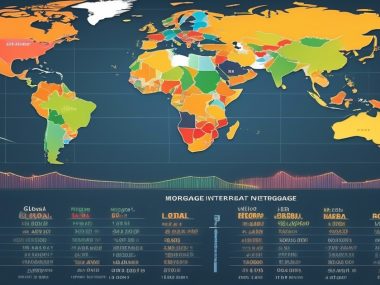Ever wondered if homeownership is a global phenomenon? Well, let’s explore together whether mortgages are a common practice in other countries. From the bustling streets of Tokyo to the serene villages of Switzerland, the concept of mortgages varies worldwide. Join me as we delve into the intriguing world of international real estate financing, housing finance, mortgage market, funding, and refinancing, and discover how different cultures approach this significant financial commitment. Excited to uncover how other nations handle homeownership through mortgages?
Key Takeaways
- Understanding the basics of mortgages is essential before exploring how they differ across countries.
- Mortgages in Sweden emphasize long-term fixed interest rates, providing stability for homeowners.
- In Ghana, mortgages are less common, with high-interest rates and short repayment periods posing challenges.
- Singapore offers innovative mortgage products like floating-rate packages, catering to diverse financial needs.
- Canada’s mortgage system combines fixed and variable rates, offering flexibility to borrowers.
- Comparing mortgage systems worldwide can help individuals make informed decisions about home financing.
Mortgage Basics
Definition
A mortgage is a loan specifically used to buy real estate, typically with a long repayment term. Unlike other loans, mortgages are secured by the property being purchased. The primary purpose of a mortgage is to enable individuals to purchase homes without paying the full price upfront. In a mortgage agreement, borrowers receive a sum of money from the lender for housing finance and agree to pay it back over time with added interest.
Key parties involved in a typical mortgage agreement include the borrower, who seeks financing for a home purchase, and the lender, usually a bank or financial institution providing the loan. There may be mortgage brokers who help borrowers find suitable lenders, navigate the application process, and finance rate mortgages.
Global Overview
Mortgage practices vary significantly across countries due to differences in regulations, financial systems, and cultural norms. While some countries have well-established mortgage markets with low-interest rates, others may have more stringent lending criteria or government intervention in mortgage lending. Mortgages play a crucial role in driving economic growth by facilitating homeownership for borrowers, financing house purchases, and stimulating construction activity worldwide.
Cultural differences also influence mortgage systems globally. For example, in some countries, large down payments are customary when purchasing property, while in others, higher interest rates may compensate for lower down payment requirements in the mortgage market.
Key Components
The essential elements of a mortgage agreement include the loan amount, interest rate, repayment term, and any additional fees such as mortgage insurance. Interest rates significantly impact overall mortgage costs for the borrower; lower rates result in lower monthly payments and less interest paid over time. Down payments are crucial for securing a mortgage as they demonstrate the borrower’s commitment and reduce the lender’s risk exposure.
Mortgages in Sweden
Structure
Mortgage loans typically consist of principal, interest, taxes, and insurance (PITI). The loan term varies from 15 to 30 years, with fixed or adjustable interest rates. In Sweden, mortgages often have long terms and high down payments.
The structure of mortgage loans differs globally based on economic conditions and government regulations. For instance, in the United States, mortgages usually have lower down payment requirements and interest rate compared to countries like Sweden. This can impact how much borrowers need to save before buying a home.
Different mortgage structures can affect borrowers differently. For example, longer loan terms may result in lower monthly payments but higher overall interest costs. Understanding these variations is crucial for making informed decisions about homeownership.
Accessibility
e countries face challenges in providing accessible mortgages due to strict lending criteria or high-interest rates. Factors influencing accessibility include income levels, credit history, and local housing markets. Initiatives like first-time buyer programs and financial education aim to improve mortgage accessibility worldwide.
Improving mortgage accessibility is essential for promoting homeownership and economic stability. By addressing barriers such as stringent eligibility requirements or lack of affordable housing options, more individuals can fulfill their dream of owning a home.
Unique Features
In countries like Japan, cultural norms influence mortgage practices by emphasizing stability and long-term planning. Innovative features such as shared appreciation mortgages in the UK allow homeowners to share property value gains with lenders. These unique characteristics reflect diverse approaches to homeownership worldwide.
Cultural influences play a significant role in shaping mortgage products and borrowing habits across different regions. For example, Islamic mortgages comply with Sharia law by avoiding interest charges. Exploring these distinct features provides insights into global real estate markets and financial systems.
Mortgages in Ghana
Homeownership Process
To own a home through a mortgage in Ghana, applicants must provide proof of income and undergo credit checks. The process involves selecting a suitable mortgage plan based on income levels. Homeowners are responsible for timely payments to avoid defaulting on their mortgages.
In different countries, the homeownership process, including the mortgage market and mortgage bonds, varies depending on local regulations, financial systems, and interest rate. For instance, in Sweden, the government offers subsidies to first-time buyers, whereas in Ghana, mortgage options may be more limited.
Challenges
Common challenges faced by individuals seeking mortgages include high-interest rates and strict lending criteria. Economic factors such as inflation, unemployment rate, and the United States can impact mortgage affordability. To overcome these obstacles, potential homeowners can improve their credit scores and save for larger down payments.
Navigating mortgage challenges requires financial literacy and strategic planning. By understanding the impact of economic fluctuations on interest rates, individuals can make informed decisions about their mortgage options.
Government Role
Governments play a crucial role in regulating mortgage markets to ensure fair practices and protect consumers. Policies set by governments influence the availability of mortgages and interest rates offered by financial institutions. In Ghana, the government has implemented initiatives to increase access to affordable housing loans for low-income earners.
Government interventions in mortgage systems aim to promote homeownership and stimulate economic growth. By providing guarantees for mortgage loans or offering subsidies, governments can support individuals in achieving their homeownership dreams.
Mortgages in Singapore
Public Housing
Public housing plays a vital role in Singapore’s real estate landscape, often linked to mortgages. These schemes aim to provide affordable housing for citizens, easing the path to homeownership. The government’s involvement ensures lower down payments and interest rates.
In comparison, countries like Sweden and Norway also have robust public housing programs tied to mortgages. They prioritize social welfare by offering subsidized loans and long-term repayment plans, fostering sustainable homeownership.
Private Sector
The private sector in Singapore offers diverse mortgage services, catering to various financial needs. Seeking mortgages from private institutions provides flexibility in loan terms and interest rates. This option allows borrowers to choose customized packages based on their preferences.
Within the private mortgage sector, healthy competition drives innovation, leading to better loan products and customer service. This dynamic environment benefits consumers by providing a range of choices for their mortgage needs.
Loan Options
Globally, mortgage borrowers can opt for fixed-rate or adjustable-rate loans depending on their risk tolerance and financial goals. Fixed-rate mortgages offer stability with consistent monthly payments, while adjustable-rate mortgages may fluctuate based on market conditions.
Specialized loan programs cater to specific borrower requirements, such as FHA loans for first-time buyers or VA loans for veterans. These tailored options provide additional support and incentives for eligible individuals.
Mortgages in Canada
Regulation
Mortgage regulation in Canada plays a crucial role in maintaining market stability. Regulations set standards for lenders, ensuring responsible lending practices and protecting borrowers. For instance, the Office of the Superintendent of Financial Institutions (OSFI) oversees federally regulated financial institutions to prevent excessive risk-taking.
Inadequate mortgage regulation can lead to financial instability. Without proper oversight, lenders may engage in risky practices, such as offering subprime mortgages, which contributed to the 2008 financial crisis. This highlights the importance of robust regulations to safeguard both lenders and borrowers.
Affordability
Mortgage affordability rate is a significant concern for homebuyers in Canada. Factors such as income levels, housing prices, and interest rates influence affordability. To improve affordability, potential buyers can consider increasing their down payment or exploring government assistance programs like the First-Time Home Buyer Incentive.
I believe understanding one’s financial situation is crucial when assessing mortgage affordability. Calculating monthly expenses and factoring in potential interest rate changes can help individuals make informed decisions about homeownership.
Market Trends
Current trends in the global mortgage market indicate varying interest rates due to economic conditions. Low-interest rates stimulate borrowing and drive housing market activity. Technological advancements have led to online mortgage applications and digital verification processes.
Analyzing market trends can provide valuable insights for prospective homebuyers or investors looking to navigate the real estate landscape effectively. Keeping abreast of emerging trends ensures making informed decisions regarding mortgages and property investments.
Comparing Systems
Similarities
Mortgage systems worldwide share common features to provide financial support for property purchases. Standard terms like down payments and interest rates are prevalent globally. Universal principles guide mortgage agreements to ensure legal and financial security.
e countries have similar mortgage practices due to global economic influences. For instance, fixed-rate mortgages are popular in many regions. In contrast, variable-rate mortgages are common in others. The presence of regulatory bodies overseeing mortgage operations is a shared aspect among various countries.
Differences
Diverse cultural and economic factors, including rate, contribute to variations in mortgage practices across nations. In some countries, long-term fixed-rate mortgages dominate, while others prefer shorter loan durations. Mortgage regulations differ significantly, impacting the accessibility of loans for individuals.
In my experience, understanding these differences can help individuals make informed decisions when seeking a mortgage abroad. For example, knowing how interest rates fluctuate based on economic conditions can aid in choosing the right mortgage type. Personal finances play a crucial role in determining the most suitable mortgage option.
Global Impact
Mortgages play a vital role in shaping the global economy by influencing international financial markets’ rate. Changes in mortgage rates can have ripple effects on stock markets and currency exchange rates worldwide. The interconnected nature of mortgage systems underscores their significance in the global financial landscape.
Accessibility and Affordability
Financial Inclusion
Mortgages play a crucial role in promoting financial inclusion by allowing individuals to invest in property and build wealth. They provide opportunities for people who may not have enough cash on hand to purchase a home outright. Initiatives such as government-backed mortgage programs aim to make homeownership more accessible to low-income individuals.
e barriers to financial inclusion in mortgage markets include strict credit requirements and limited access to banking services for marginalized communities. To address these challenges, organizations are developing alternative credit scoring models and providing financial education to improve access to mortgages for underserved populations.
Initiatives aimed at enhancing financial inclusion through mortgages include community outreach programs, where financial institutions work closely with local communities to provide tailored mortgage solutions. These initiatives focus on increasing financial literacy and offering flexible mortgage products to accommodate varying income levels.
Barriers to Access
Common barriers preventing individuals from accessing mortgages include low credit scores, insufficient income, and high debt levels. Socio-economic factors like income inequality and housing market fluctuations also contribute to these barriers. Strategies such as down payment assistance programs and mortgage counseling services can help individuals overcome these obstacles.
Addressing socio-economic factors is crucial in overcoming mortgage access barriers, as they directly impact an individual’s ability to qualify for a loan. By providing resources for financial planning and offering support during the homebuying process, organizations can empower individuals to navigate the complexities of obtaining a mortgage successfully.
Affordability Index
An affordability index measures the ability of households to afford a home based on their income levels and prevailing housing prices. These indices take into account factors like interest rates, property taxes, and insurance costs to determine housing affordability. By comparing affordability indices across different countries, policymakers can gain insights into the overall housing market health and identify areas that require intervention.
Calculating affordability indices involves analyzing median household incomes, average home prices, and other relevant data points specific to each region or country. These indices serve as valuable tools for policymakers, enabling them to make informed decisions regarding housing policies and regulations.
Unique Global Features
Government Interventions
Governments worldwide implement various policies to regulate mortgage markets. For instance, in the US, the Federal Housing Administration insures mortgages, promoting accessibility for low-income borrowers. In contrast, Canada’s government offers mortgage insurance through the Canada Mortgage and Housing Corporation, enhancing security for lenders.
These interventions significantly impact mortgage affordability. By providing guarantees and incentives, governments can lower interest rates and down payment requirements. This enables more individuals to achieve homeownership, fostering financial stability and wealth accumulation.
Government interventions play a crucial role in promoting homeownership. Through initiatives like first-time buyer programs and tax incentives, governments encourage citizens to invest in real estate. While these interventions have positive effects on homeownership rates, their long-term sustainability remains a subject of debate.
Cultural Influences
Cultural norms profoundly influence mortgage practices globally. In countries like Japan, where saving is prioritized over borrowing, individuals exhibit a strong reluctance towards taking on debt for homeownership. Conversely, in the United States, a culture of investment and property ownership drives high homeownership rates.
Attitudes towards homeownership are deeply rooted in cultural values. For example, in countries with collectivist societies like South Korea, owning a home symbolizes stability and family honor. This cultural emphasis on housing impacts how individuals perceive and pursue mortgage opportunities.
Cultural factors not only shape attitudes but also influence decision-making processes related to mortgages. Understanding these nuances is crucial for lenders to tailor their services effectively based on cultural preferences and practices.
Innovative Practices
Globally, there are innovative approaches revolutionizing the mortgage lending landscape. Platforms utilizing blockchain technology streamline verification processes and enhance security in transactions. Peer-to-peer lending models provide alternative financing options beyond traditional banks.
Technological advancements continue to transform the mortgage industry by offering online platforms for loan applications, approvals, and payments. These innovations improve convenience for borrowers while increasing efficiency for lenders in managing mortgage portfolios.
Creative solutions are emerging to address traditional challenges in mortgages. For instance, shared equity schemes allow multiple parties to invest jointly in a property purchase, reducing individual financial burdens while promoting collective ownership benefits.
Summary
In exploring mortgages across various countries, I’ve uncovered unique systems and features that shape homeownership worldwide. From Sweden’s long-term fixed rates to Ghana’s flexible terms and Singapore’s government interventions, each nation offers distinct advantages and challenges in accessing mortgages. Canada stands out with its balanced approach, emphasizing affordability and regulation. Comparing these diverse systems highlights the importance of understanding global mortgage practices for informed decision-making.
Understanding how mortgages function globally can provide valuable insights for individuals navigating the housing market. Whether you’re a first-time buyer or considering international investments, recognizing the differences in mortgage systems can help you make informed choices. Stay curious and keep exploring the world of mortgages to find the best fit for your homeownership goals.






